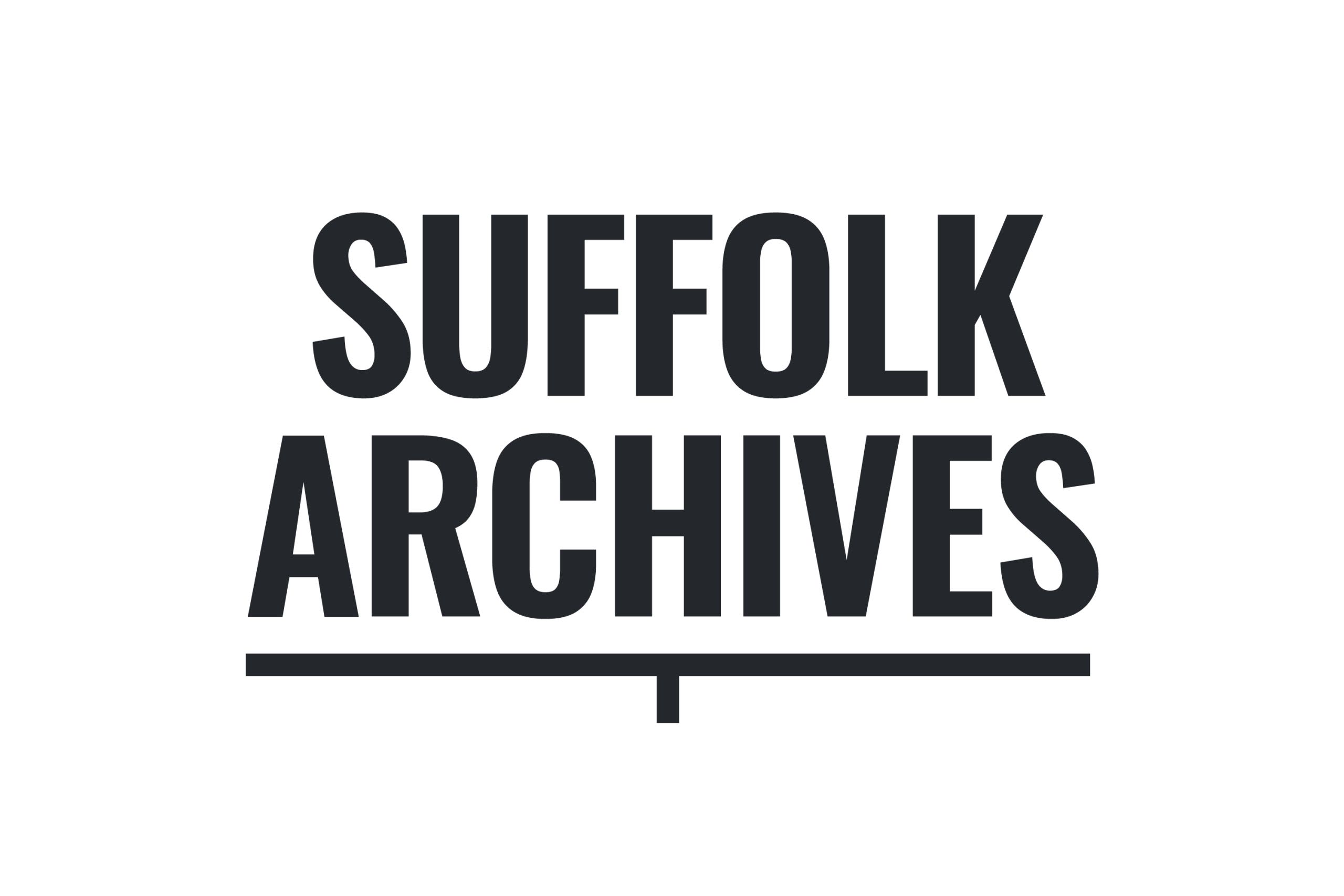'Workin' on those airdromes'
Discovering the experiences of Black American servicemen in Suffolk during WWII
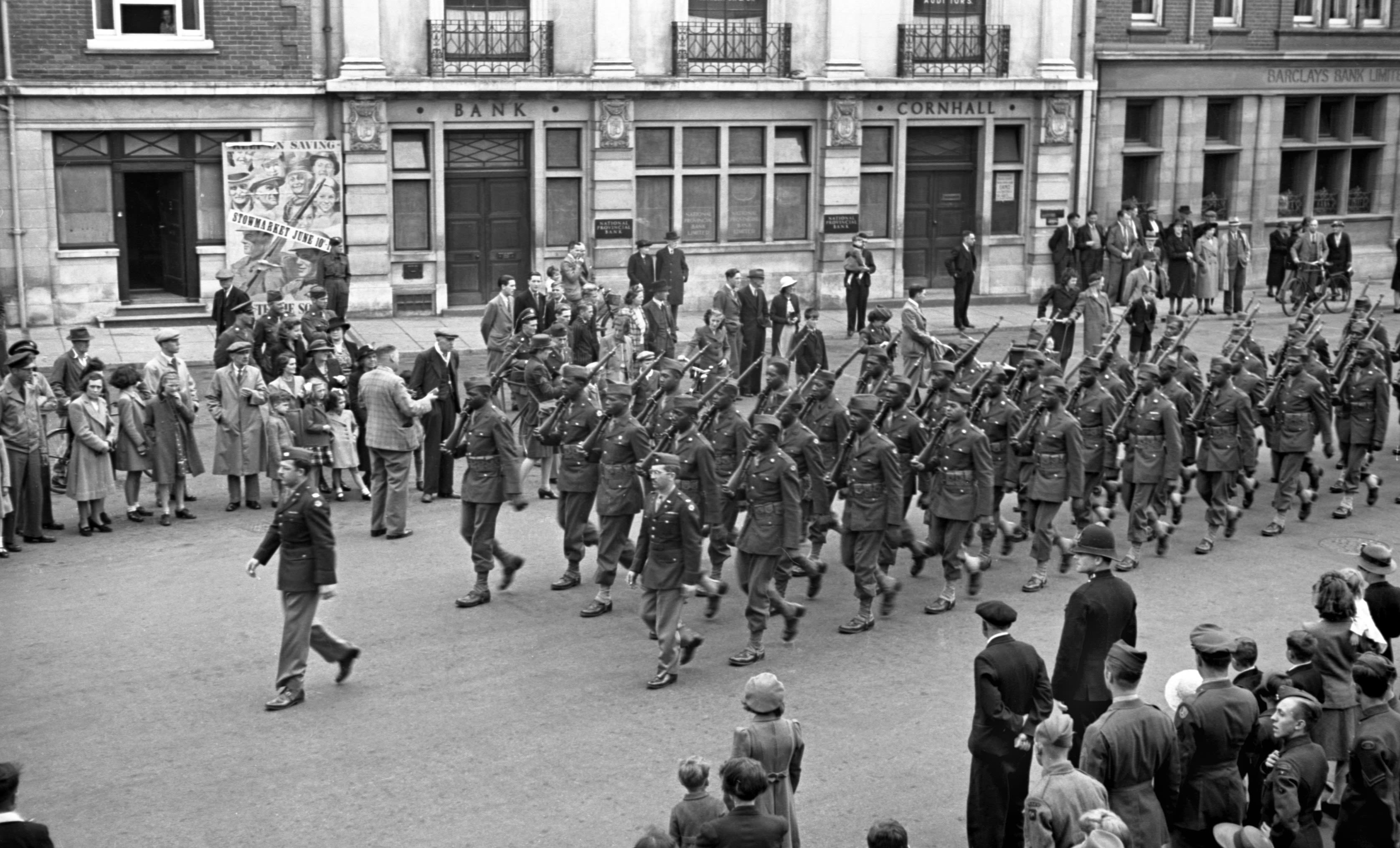
'Workin' on those airdromes'
During the Second World War the East of England hosted a ‘Friendly Invasion’ of the US Army Air Force (USAAF) to conduct operations with the RAF, to progressively destroy the German war machine through strategic bombing.
By April 1944 there were 71,000 American GIs in Suffolk alone and it has been estimated that there was one GI to every six civilians. The stories of this ‘Friendly Invasion’ have been well told and many recall ‘rose tinted’ childhood memories of receiving gum and candy, but there is one story which has been neglected.
Before the majority of US troops arrived, there was a smaller contingent of predominantly Black engineers who arrived in Suffolk in 1942 to contribute to the construction of 19 US Army Air Force bases. Other Engineers, Quartermasters and Truck Battalions were also stationed in Suffolk to assist with keeping the supply operations functioning.
A group of volunteers have come together at Suffolk Archives to discover the experiences of the Black US servicemen who came to Suffolk, first to build the airfields and pave the way to the ‘white flyers’ who came after. The team have dug deep to uncover the stories of these Black servicemen in Suffolk, what they achieved, how they were treated, and how they worked, played and loved.
The group soon discovered that there was a lack of Black voices in the sources they were finding. This is because unlike white servicemen, Black units very rarely created veterans’ groups, had reunions, and did not have their oral histories recorded. This group was keen to ensure that the Black servicemen’s experiences are shared though the archival research in African American contemporary newspapers, memories of local people and the memoirs of Black officials such as Walter White of the NAACP. This exhibition shares some of the stories discovered and we leave it to the viewer to imagine how these men must have felt and if and how their experiences serving in Suffolk had an impact on their future lives back in the US.
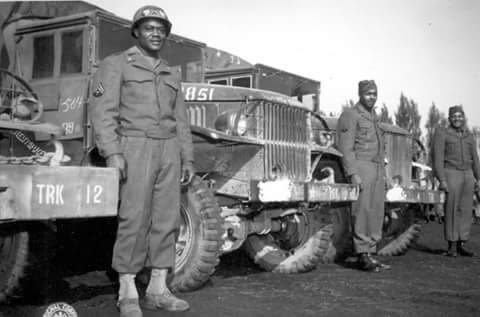

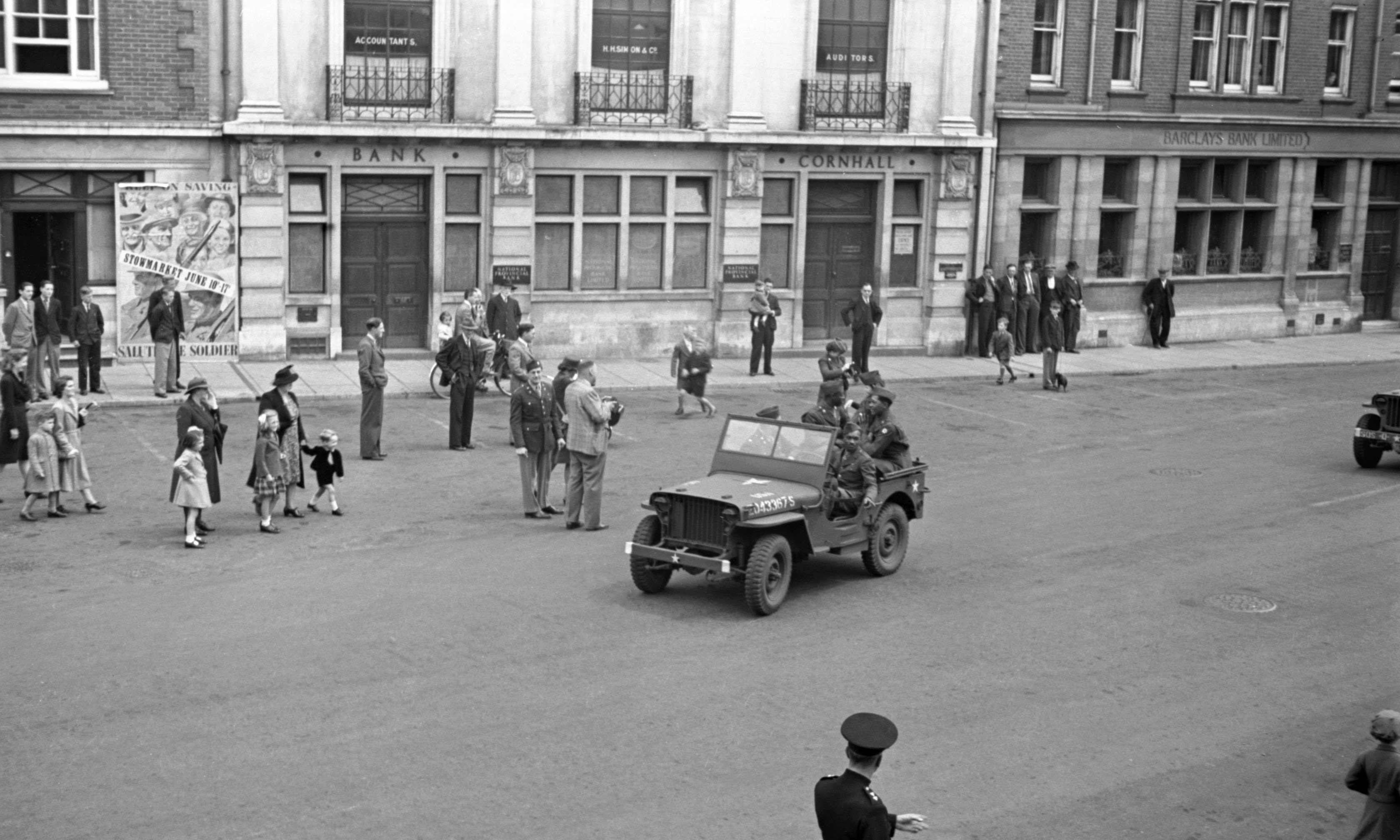
Segregation in the UK?
At home African Americans were subject to legislation known as the Jim Crow Laws, which curtailed civil rights and imposed segregation. Whilst serving overseas, most Black US servicemen were assigned to segregated transportation, supply, and construction units.
Supreme Allied Commander, General Eisenhower issued a policy on 16 July 1942 stating it was “the desire of this headquarters that discrimination of negro troops be sedulously avoided”. This led to the implementation of the “separate but equal” doctrine for US forces in Britain.
The “separate but equal” doctrine gave equal rights to all troops regardless of colour, but they would be separated to enjoy those rights. When the Black engineers arrived in Suffolk to build and service the airfields, it appears that Suffolk people generally welcomed these men into their communities. However, once the white servicemen arrived to populate the operational airbases, racial tensions began to surface. US military authorities responded with a system of de facto segregation.
Towns and villages were designated Black or white only areas. Cinemas were assigned white or black nights and even pubs were designated as “exclusively for coloured troops”.
This system of imposed segregation of Black servicemen in the UK would lead to hostility with both servicemen and ordinary people in Suffolk.
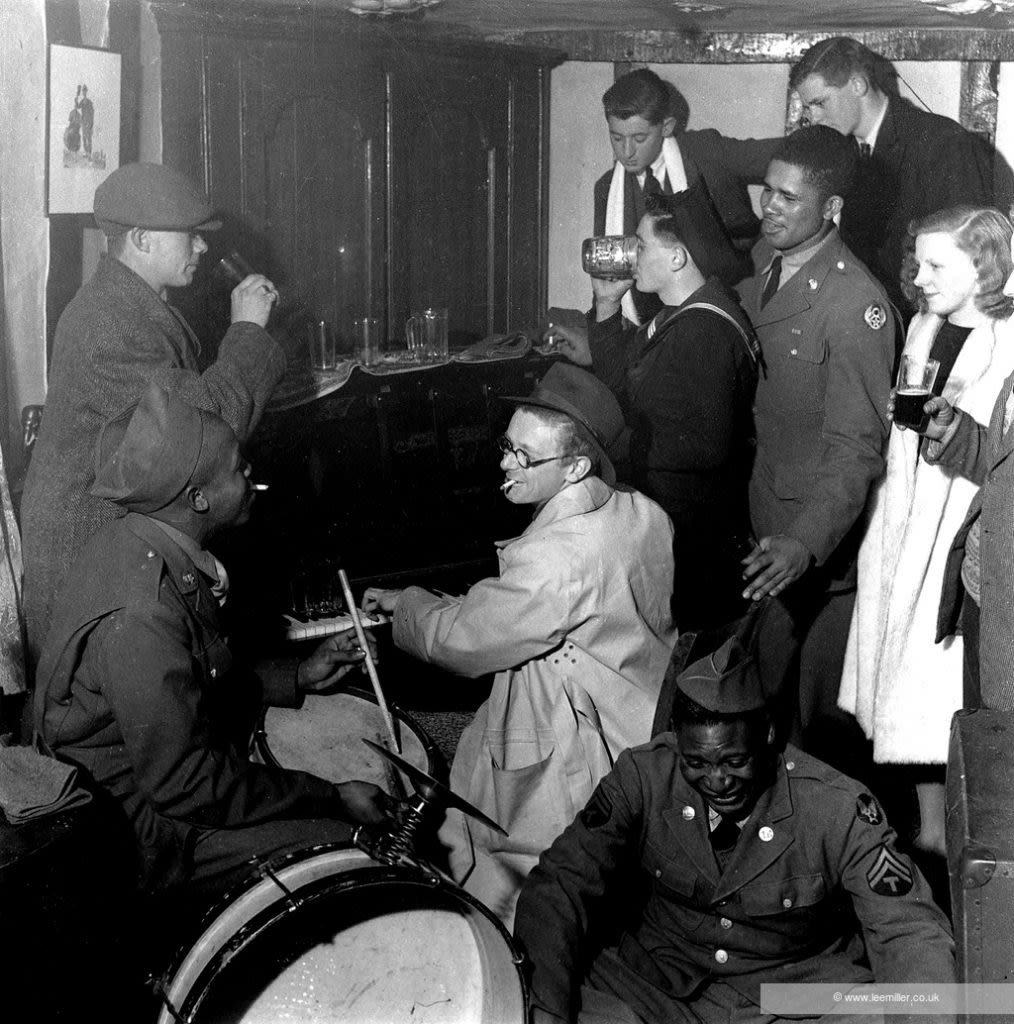
Building the 'airdromes'
Of the 157 aviation engineer battalions raised within US forces during the Second World War, 48 were made up of Black personnel. These segregated 800-man units constructed airfields overseas, and once completed, were tasked with defending them.
The majority of the 48 units served in the Pacific and China-Burma-India theatres of war, but some served in Europe too. African-American troops worked on the construction and maintenance of several airbases in Suffolk, shown on this map:
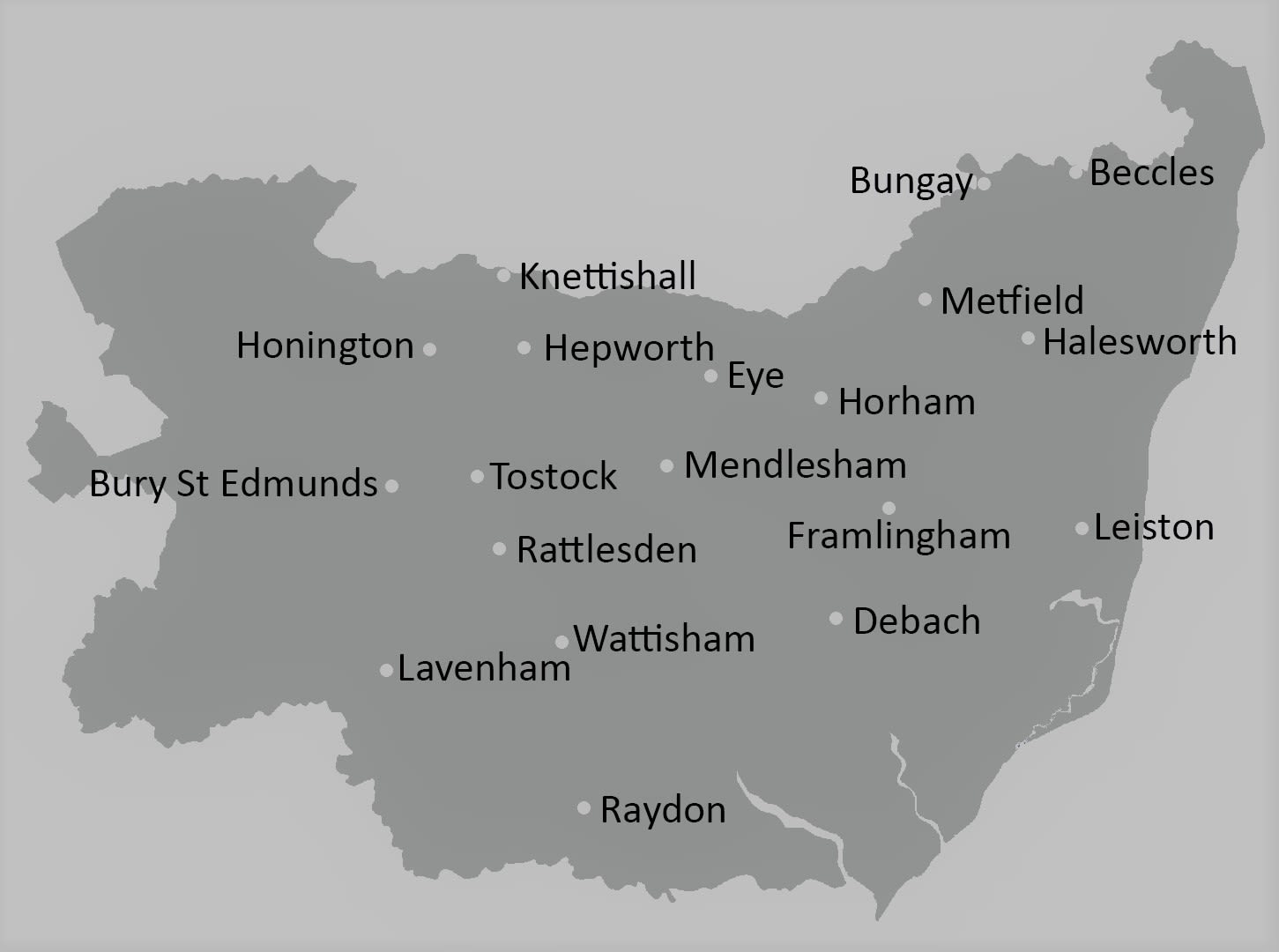
Airfields in Suffolk where Black aviation engineers are known to have worked
Airfields in Suffolk where Black aviation engineers are known to have worked
RAF Eye (USAAF Station 134) was the first airfield in the European Theatre of Operations (ETO) to be constructed entirely by African-American engineers. It was built by battalions from the 923rd Engineer Aviation Regiment (the 829th, 827th, and 859th). Work began in September 1942; expected to take 90 weeks, it was complete in 56. RAF Eye was operational from December 1943, and fully completed by April 1944, and was used by the Eighth Air Force 490th Bombardment Group (Heavy). In a somewhat unusual arrangement, some of the hardstandings at Eye were over a public road that bisected the airfield, and local traffic had to be stopped when aircraft were moved to and from those hardstandings.
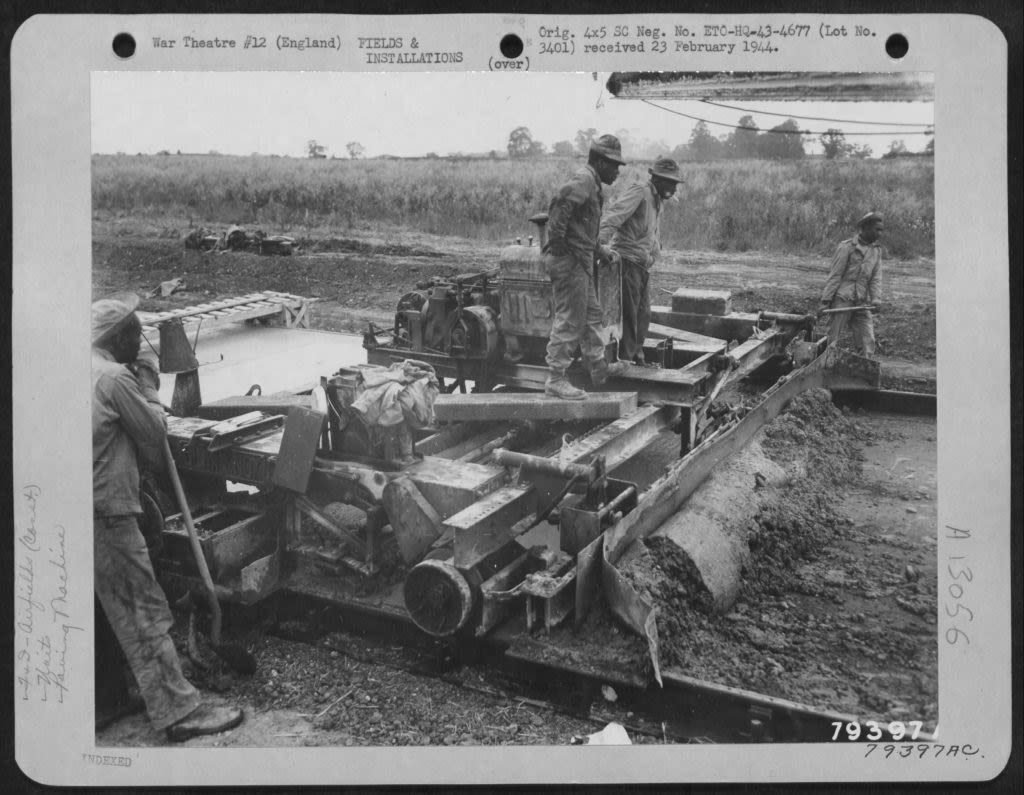
On 8th December 1943 the East Anglian Daily Times reported on the handover of six newly completed airfields to the US Air Force. The handover included a parade of the engineering troops who had built the airfields, followed by the heavy equipment they had used. The article does not give the location of the parade but as Eye was the only airfield wholly constructed by Black Aviation Engineers, we can assume that they are referring to Eye airfield.
One airfield was entirely constructed by the coloured American troops... General Moore and Col. Kesler took the salute at an impressive march past of the coloured engineering units, marching nine abreast with their regimental colours and stars and stripes and headed by the drum and bugle corps. Behind followed their heavy mobile equipment used in the construction of the drome and also their guns and armoured vehicles, one mission of these engineers being to defend the dromes as well as build them.
The parade shown in this film from British Pathe is at an unknown location dated 1944, but is an example of the parade described above in the East Anglian Daily Times:
This film from the American Air Museum give some idea as to what went into the construction of the airfields:
The 829th Aviation Engineers Battalion (AEB) also worked on the construction of RAF Debach, along with the 847th AEB, another segregated unit of Black personnel. The 493rd Bombardment Group (Heavy) flew their first mission from Debach on D-Day, 6th June 1944.
Following the Allied invasion of Europe, the 923rd Aviation Engineer Regiment was transferred to France in September 1944 Their mission was to build and repair forward operating airfields in mainland Europe as the Allied armies advanced across France and into Germany.
The work carried out by the engineer aviation units was not without risk. Direct enemy action against the units was minimal, although the airfields were targets for enemy bombers. The men were operating heavy specialised equipment in difficult terrain whilst combat operations were ongoing. They were clearing mines and damaged aircraft. At times they were responsible for moving bombs for airfield shipment. 36 men of the 923rd sadly lost their lives in the course of their duties.
Music and Morale
Morale is key to the development of loyalty and motivation within any organisation. In 1943, low morale among Black troops in the US and abroad was a cause of concern for the military. There were race riots and conflagrations in Detroit and in Beaumont; in the UK, there were riots at Bamber Bridge in Lancashire and in Launceston in Cornwall. In Ipswich, white troops were arrested for threatening to beat up Black troops seen with white women.
Aviation support units such as the 923rd Engineer Aviation Regiment worked long hours doing physically gruelling work. The paucity of, and limited access to, facilities available for Black troops in the segregated army compared to the facilities for white troops was a source of constant frustration and dissatisfaction. Whilst there were no major policy changes during the war, and the military remained segregated until 1948, some measures were taken to recognise the achievements of black troops and to boost morale, including creating a Black only Choir.
The ETOUSA [European Theatre of War USA] Morale and Special Services Guide issued in May 1943 advised officers that “Music is a language everyone speaks. The soldier speaks it with gusto. He’s a singing man— under his improvised shower, when he marches. At times he sings when he fights.” There was some opposition to the idea of the choir as a way to boost morale as it reinforced a stereotyped image. Many people believed that it would be better to show the men doing valuable war work. However, recruitment to the choir was popular amongst Black Servicemen who were stationed in Suffolk.
This chorus of 200 enlisted men from the 923rd Engineer Aviation Regiment became famous across the world. They sang in England in draughty Nissen Huts, in churches, in village halls and in The Royal Albert Hall. They sang in France, for villagers and for other Allied troops.
Men were recruited to the chorus from throughout the regiment. Rehearsals were fitted in around the construction of airfields in East Anglia. The fame of the chorus grew, and they were invited to perform at prestigious locations in the UK. Noted tenor Roland Hayes was invited to come to London and perform with the chorus. Marc Blitzstein composed ‘Freedom Morning’ which he dedicated to the struggles of black soldiers and he arranged Earl Robinson’s ‘Ballad for America’ for the chorus.
On Saturday 25 September 1943 the New York Age reported that “Roland Hayes and a Big Choir of Negro Soldiers” in England were to sing with the London Symphony Orchestra.
“Rehearsals for the concert…are held in Nissen hut theaters in a section of rural England. Members of the chorus, all of whom are working double shifts to rush the completion of airdromes, are devoting whatever free time they have to the practice sessions and have given up all pass privileges for the past month”.
Walter White of the National Association for the Advancement of Coloured People (NAACP) visited England in Autumn 1943, as part of his tour of the European and African Theatres of War, meeting Black service personnel and reporting on conditions and experiences. In his book A Rising Wind he describes attending a special performance by the chorus in a dimly lit, cold and draughty Nissen hut. His party had to drive through the black-out to reach the base. He recalled that there was no light, no moon or stars and no road signs. The men were cold and dressed in their mud-stained work clothes. He described the singing as “a moment of superlative beauty amid the perils and discomforts of war”.
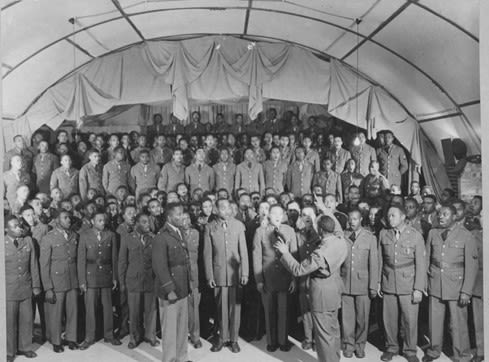
Choir performing at Eye – 490th Bombardment Group Archives
Choir performing at Eye – 490th Bombardment Group Archives
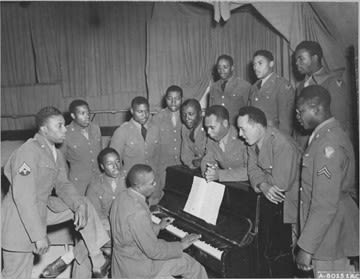
Choir rehearsing at Eye – 490th Bombardment Group Archives
Choir rehearsing at Eye – 490th Bombardment Group Archives
The BBC Archives have recordings of one of the choir’s performances during the Autumn of 1943. You can listen to here:
The chorus performed at The Royal Albert Hall on 28 and 29 September 1943 and then toured the country performing in Manchester, Edinburgh and in St Andrews Hall in Glasgow in October 1943. The concerts also featured a performance of Freedom Morning by the London Symphony Orchestra. The piece was described as a ‘tone poem set to traditional negro spirituals and songs’. The US Ambassador to London John ‘Gil’ Winant reportedly said that hearing the chorus perform at the Royal Albert Hall was one of the two or three great emotional moments in a man’s life.
The performance was featured in the Life Magazine in November 1943, where Private McDaniel explained about the soldiers’ love of spirituals:
“Christianity means a lot to us dark boys. A man that can sing a good spiritual can always find his way into another boy’s heart"
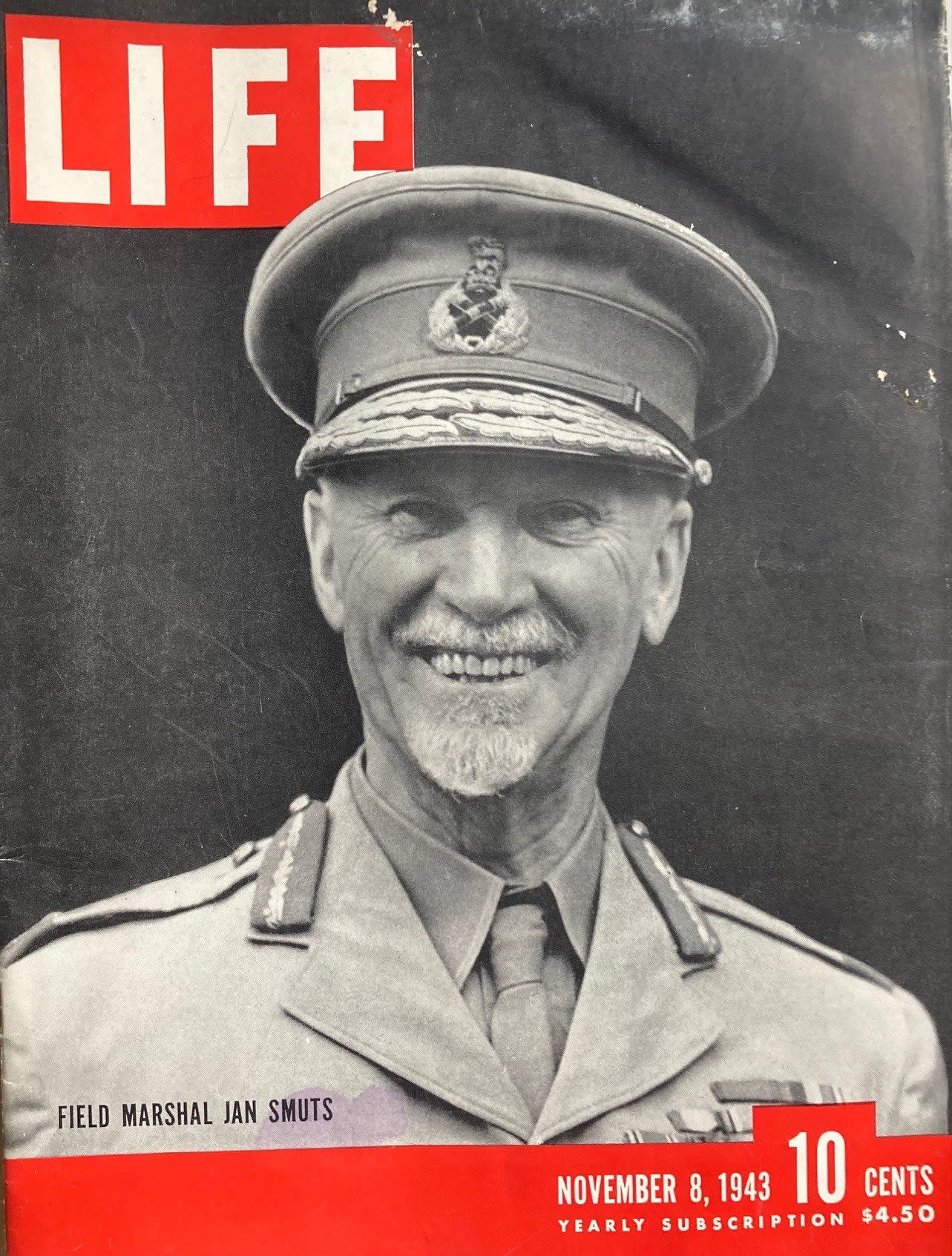
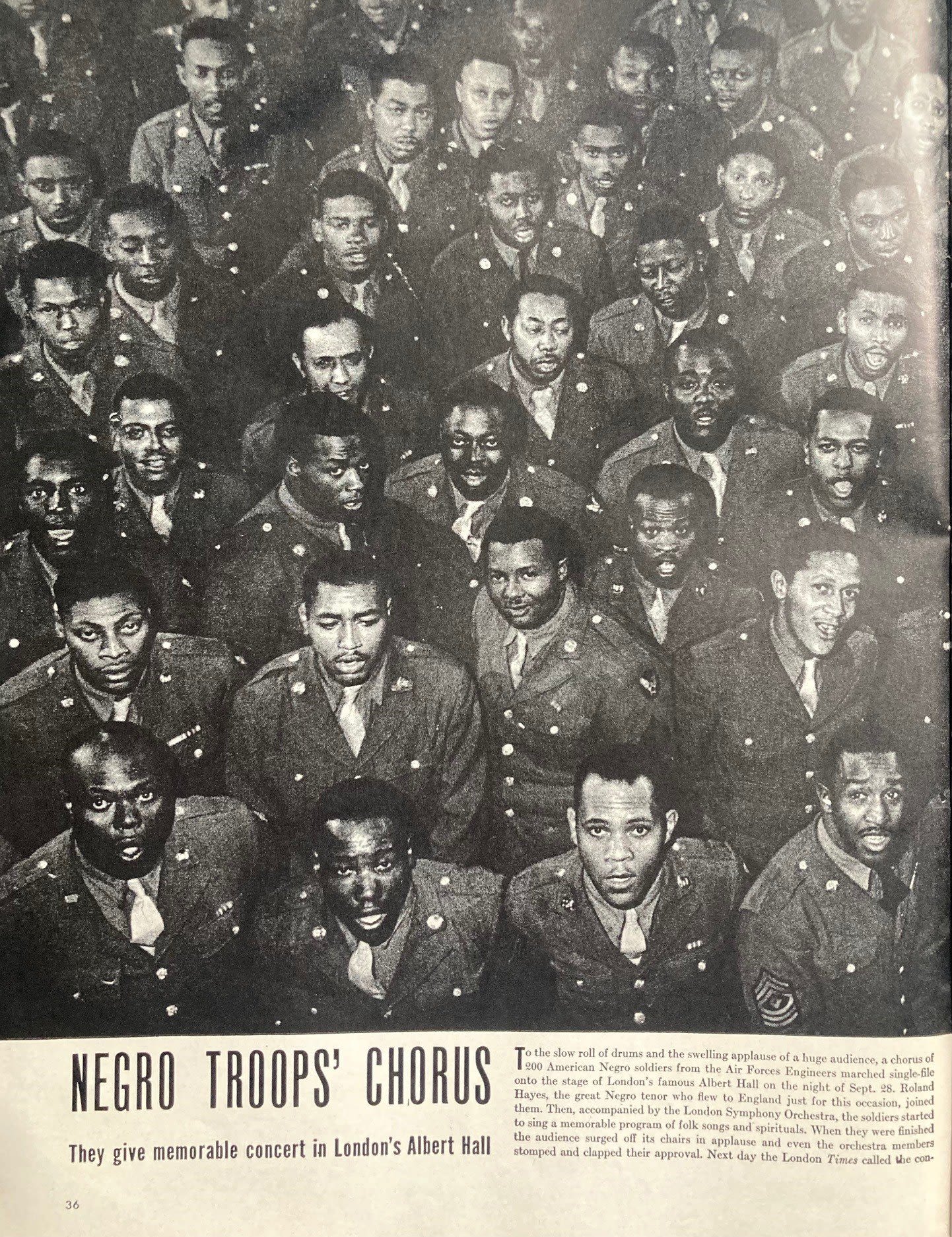
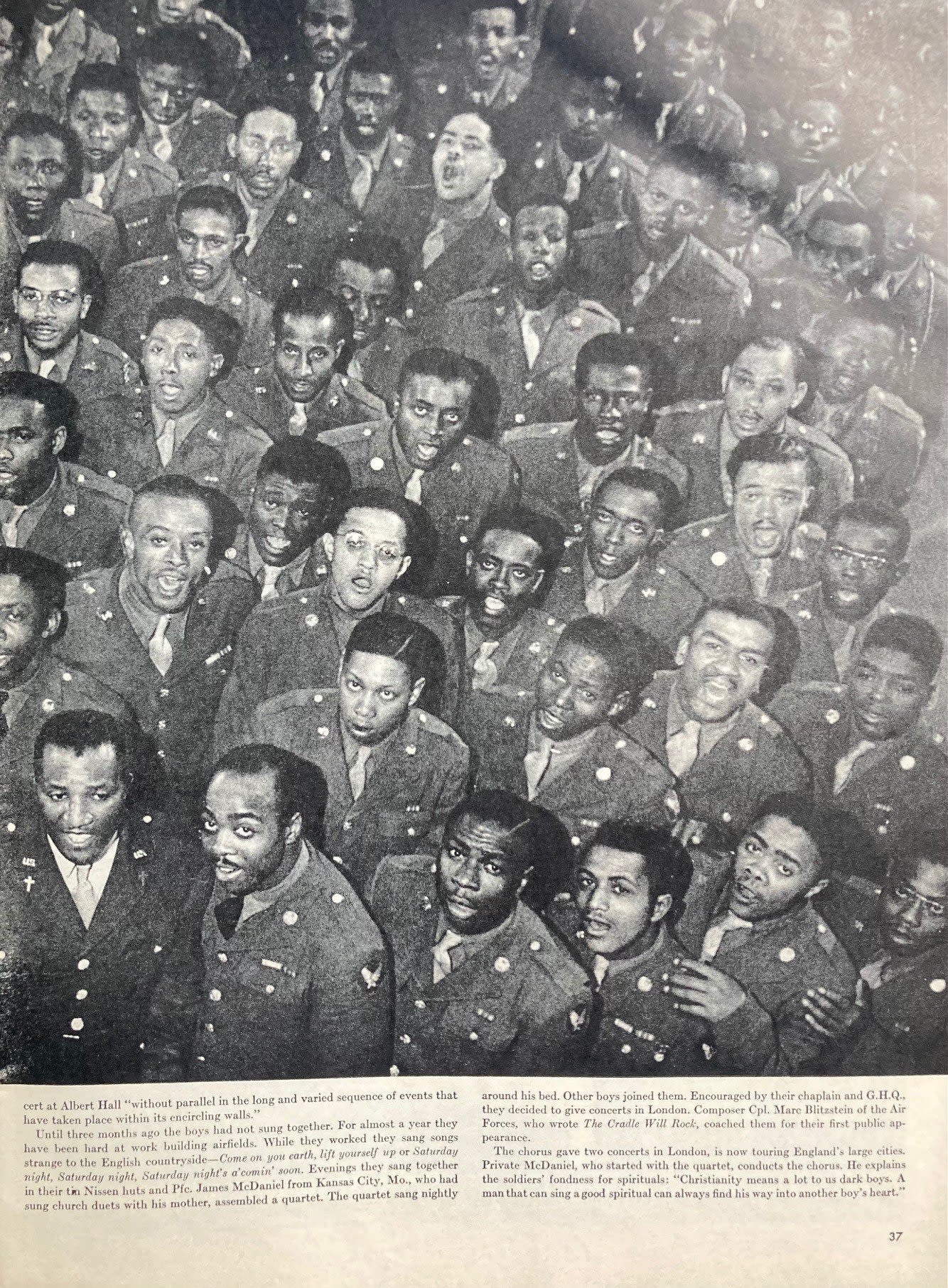

Life Magazine Nov. 8, 1943
Life Magazine Nov. 8, 1943

Life Magazine Nov. 8, 1943
Life Magazine Nov. 8, 1943

Life Magazine Nov. 8, 1943
Life Magazine Nov. 8, 1943
Welcome to Suffolk
One of the first mentions in the press of the US Black Servicemen in Suffolk would appear to support Jim Crow prejudice. In September 1942 ‘coloured American Troops’ were banned from a dance in Eye. Though it is unclear as to where this prejudice originated, local residents appear to have made a rapid and clear response, to support the men. An article the very next day stated Women’s Voluntary Service (WVS) members would be ‘creating a canteen and recreation centre’ and, said the Mayor, a committee formed to explore other ways to make our guests feel at home’.
Other contemporary newspaper articles reveal numerous occasions of Black GIs taking part and indeed hosting, a wide range of activities involving the local community. Some events seem to be linked with Methodist church, but they also include a wide variety of occasions such as organising children’s parties, dances, baseball demonstrations, as well as local concerts by members of the famous 923rd Aviation Regiment Choir. Indeed, the disappointment expressed at their inability to attend a garden party at Fersfield because of military duties, demonstrates their popularity with local Suffolk people. Here is a small selection of the many positive stories reported in the local press, which give a flavour of these men’s lives whilst stationed in Suffolk and help to illustrate how they were accepted and integrated into the local community.
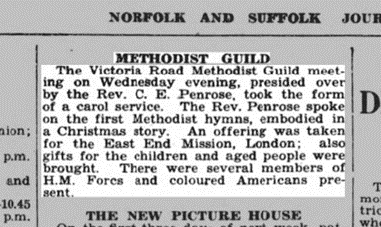
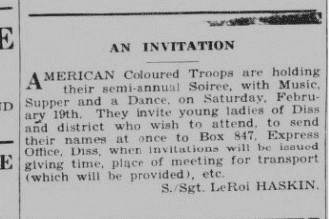
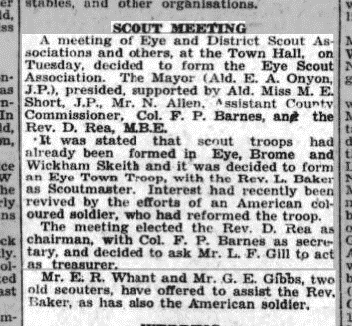
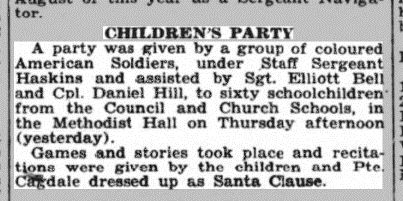
In 1944 the American Heavyweight Champion of the World, Joe Louis, visited Stowmarket in Suffolk to meet with thousands of Black servicemen stationed across East Anglia. Louis travelled more than 21,000 miles and staged 96 boxing exhibitions before two million soldiers.
On the day of celebration, Black troops paraded through the town to celebrate ‘Salute a Soldier’ week before joining Louis at nearby Haughley Park for festivities, which included a boxing match to entertain servicemen from the aviation engineer regiments of the Eighth Air Force Division.
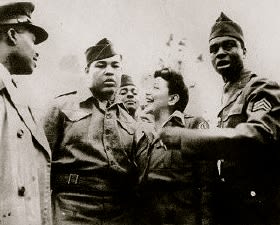



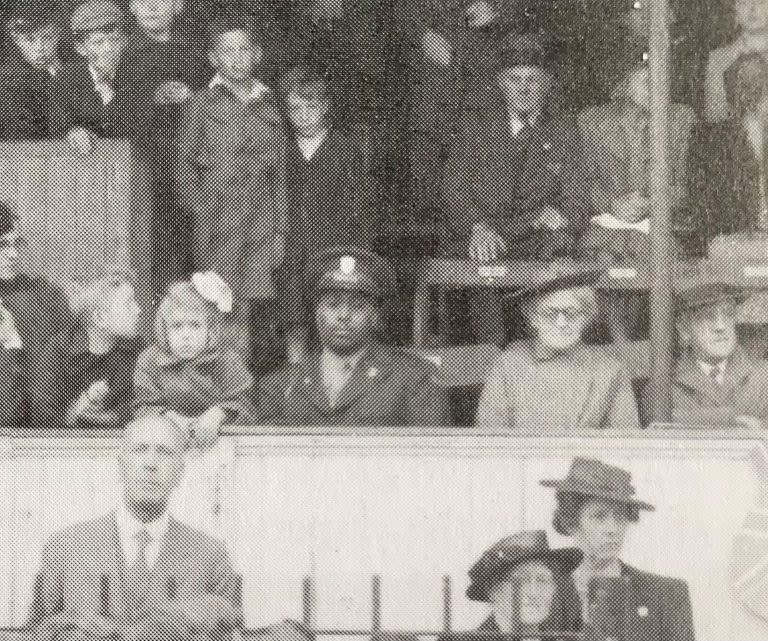

©George Wilden Collection courtesy of Stowmarket Local History Group, Salute a Soldier Day in Stowmarket 3 June 1944
©George Wilden Collection courtesy of Stowmarket Local History Group, Salute a Soldier Day in Stowmarket 3 June 1944

©George Wilden Collection courtesy of Stowmarket Local History Group, Salute a Soldier Day, Stowmarket 3 June 1944
©George Wilden Collection courtesy of Stowmarket Local History Group, Salute a Soldier Day, Stowmarket 3 June 1944

Working under the well known signature byline of Giles, the cartoonist brightened many editions of The Daily Express with his indomitable family of characters who reflected the humour and stubborn determination that sustained Britain during the war. Here he is seen in a jam session with a group of American GIs in the pub near his studio in Suffolk. Copyright Lee Miller Archive
Working under the well known signature byline of Giles, the cartoonist brightened many editions of The Daily Express with his indomitable family of characters who reflected the humour and stubborn determination that sustained Britain during the war. Here he is seen in a jam session with a group of American GIs in the pub near his studio in Suffolk. Copyright Lee Miller Archive

USAAF Black Serviceman watching a football match at Portman Road (EADT)
USAAF Black Serviceman watching a football match at Portman Road (EADT)
Many black US servicemen made friends in the local area. Carl Giles, the famous Daily Express cartoonist moved to Ipswich in 1943. He could regularly be found drinking and playing jazz in his local pub, The Fountain in Tuddenham St Martin near Ipswich, with black servicemen who were based at nearby Debach. This photograph was taken by the war photographer Lee Miller for a spread on Giles in British Vogue in 1944.

Racial Tensions
When white plane crews (known as the ‘white flyers’) began to arrive in Suffolk in 1943 and 1944 to start flight operations, racial tensions began to appear as white servicemen, especially from the southern states, were confounded by the liberal freedoms that many of the Black servicemen had in Britain, and with the relative acceptance by Suffolk people. Being served in a bar, walking on the pavements and more incredulously, walking out with a white women was in stark contradiction to the Jim Crows laws of back home. These interactions between the Black and white servicemen often led to conflict and the intervention of the military police.
Smaller towns like Eye and Diss often had “white nights” and “black nights” for passes to segregate US troops in their time off. In larger towns the US Army established a network of Black-only and white-only pubs and dance halls. In Ipswich, for example, a centre for white airmen and Black support and construction troops in East Anglia, designated a number of pubs as “exclusively for coloured troops”, particularly in the area around St Peter’s Street where the American Red Cross Club for Black GIs was located. Rougham was placed off limits to whites and the Duke of York in Ditchingham, near Bungay, which serviced Flixton Airfield, was for blacks only.
Johnny Speight, based in East Anglia during WW2 recalls….
‘I was in a Suffolk pub one evening and there was a…riot. All these Americans were objecting to one of their black soldiers who had taken up with a local girl. She was white of course. They had him up at one end of the bar and they were going to lynch him…terrifying it was”
Historian, R Douglas Brown suggests that the only serious evidence of racial tension occurred within the US Services. Historian, Graham Smith states ‘Blacks were warmly welcomed in Britain, and the action of the white Americans in furthering a colour bar was roundly condemned.’ Although it must be noted there was an almost universal dislike of the blacks associating with white women.
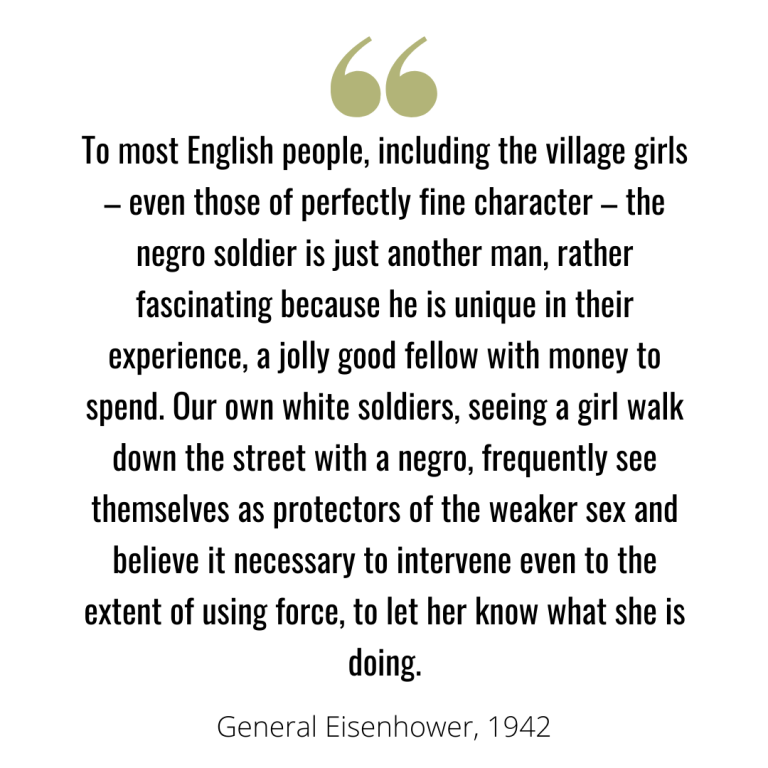
In 1942 General Eisenhower stated that British society was ‘devoid of racial consciousness’:
In 1942 General Eisenhower stated that British society was ‘devoid of racial consciousness’:
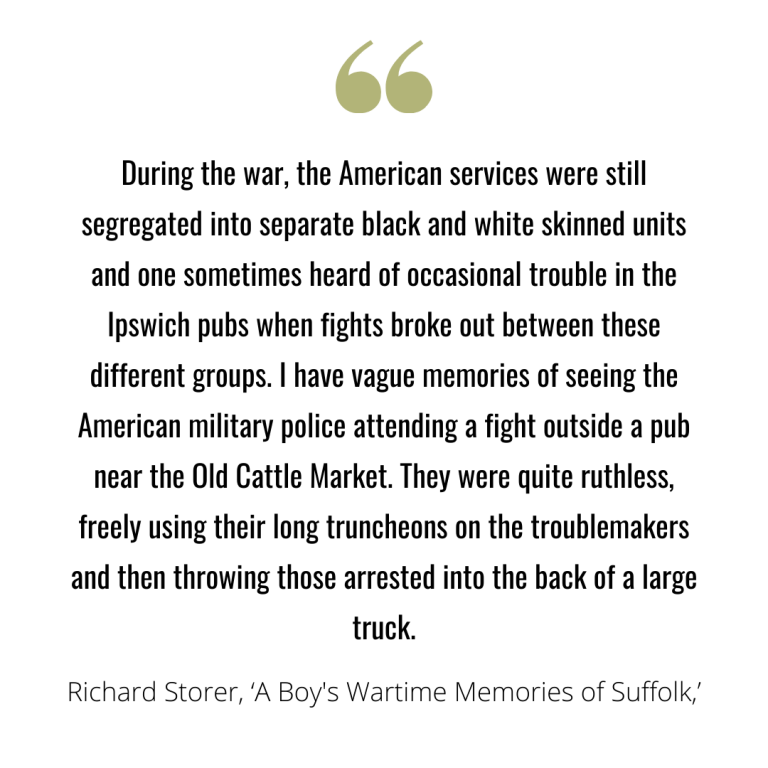
From the BBC’s Wartime Memories project
From the BBC’s Wartime Memories project
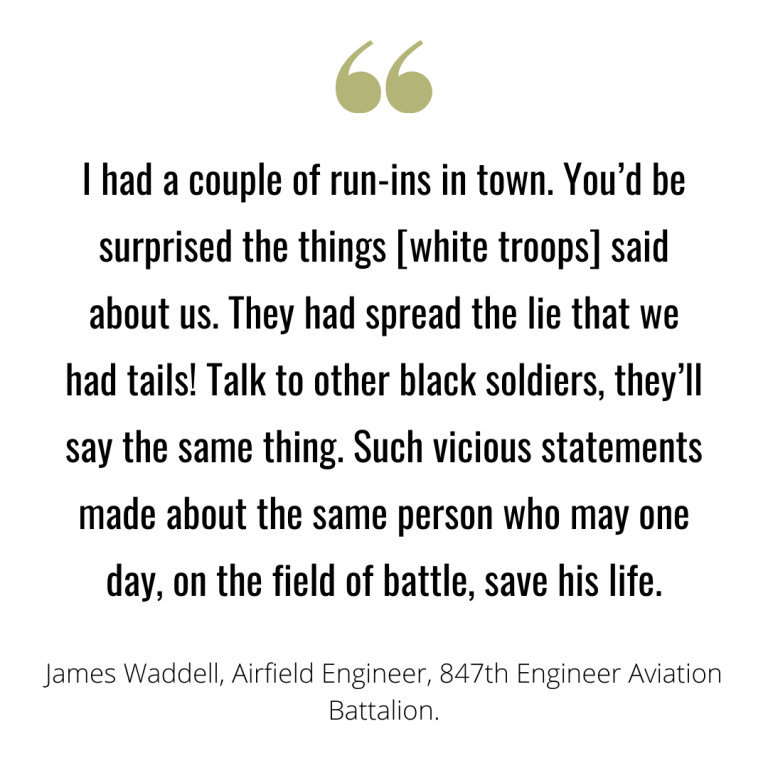
From the American Air Museum – read more here. James Waddell, stationed at Eye and Debach, as part of the 847th Aviation Engineers Battalion, recalled:
From the American Air Museum – read more here. James Waddell, stationed at Eye and Debach, as part of the 847th Aviation Engineers Battalion, recalled:
Relationships, Love and "Brown Babies"
During the course of the Second World War, interracial marriages were still illegal in thirty out of forty-eight US states. The arrival of Black US Servicemen to England and the inevitability of relationships being formed with local women was viewed by the US military with some trepidation. This can be evidenced by the actions taken by white US commanders, in refusing Black servicemen permission to marry. In 1944 The Diss Express Newspaper issued a cautionary warning to East Anglian women who were contemplating a relationship with servicemen that,
‘a young women marrying a member of the United States Armed Forces will not be allowed to accompany him on his return to the United States…it should be remembered that in over 20 states of the Union, marriages between white and coloured persons are illegal and prohibited’
Despite opposition, a number of relationships were struck up between Black US servicemen and local women in Suffolk and it is estimated that around 2000 children were born nationally from these relationships during wartime. The mothers of the children, given the inability to marry, often faced societal disapproval and pressure to give their baby up, whilst the father was frequently transferred once the pregnancy became known. Pregnant girls under the age of eighteen also faced the threat of being placed in reform schools or faced juvenile courts, even if the fathers expressed a desire to support the girl and the child.
The Diss Express Newspaper reported on several such cases in 1944.
The experiences and stories of servicemen’s children growing up in Suffolk, have until recently been a largely neglected part of history. These stories are now however coming to the fore and have been the subject of recent research.
Mick Brummitt was born in 1944 in Ipswich, the son of Jimmie W. Oliver of the 829th Aviation Engineering Battalion and his mother Sylvia, from Ipswich. Mick’s parents had met whilst Jimmie was serving at the Debach air base. After Mick’s birth, Jimmie was posted along with his battalion to France and eventually lost contact with Sylvia. Mick was brought up by his mother in Ipswich, in a loving environment and with the support of his half-brother, he was later able to find out further information on the background of his father. Although Mick never got to meet his father, who had died at the age of 47 or to find a photograph of him, he was however able to meet his American half-brother for the first time in Georgia in 2004.
Not all children were as fortunate, and a number of children were placed in care homes. An example being Babs Gibson Ward, whose story has been explored by Lucy Bland’s book Britain’s “Brown Babies”. Like Mick Brummitt, Babs was born in Ipswich in 1944. Her father was a Black US serviceman based in Suffolk and her mother who was already married. She initially passed Babs off as her husband’s child, before shortly admitting the truth. Babs was subsequently placed in a Barnardo’s home in Long Melford, Suffolk and later fostered, enduring a turbulent childhood. Babs, who was told by her teacher as a child that ‘she did not have the same ability to learn’ as a white child, went on have a successful career in nursing, tutoring and achieved a Masters in music in her 70.’s
Please note that the term "brown babies” is a contemporary term which has now been adopted by the community of children who were born of US Black servicemen and white mothers.
Returning Home
The civil rights movement in the US gained a new impetus as hundreds of thousands black servicemen who served in Europe during WWII, discovered that racial discrimination was not as oppressive in countries such as the UK and France. Many realised that the US could and should be a land free of racial discrimination. In 1948, President Harry Truman signed the Executive Order to desegregate the US armed forces.
The Servicemen’s Readjustment Act 1944 (known as the GI Bill) allowed sweeping benefits for veterans including college tuition, low cost mortgages and loans. Although the Bill did not exclude African Americans, its structure to allow state administration enabled southern states to enforce the Jim Crow laws through its delivery. Black veterans had trouble securing its benefits and were ultimately excluded from the prosperity of the post war boom. (Read more at https://www.history.com/news/gi-bill-black-wwii-veterans-benefits)
As a result of their experiences in WWII and the subsequent inequality of the benefits of the GI Bill, many African Americans created a more widespread and organised civil rights movement, resulting in the eventual removal of Jim Crow laws in 1964. We would like to think that the experiences of these black servicemen in Suffolk contributed to their commitment to bring about changes back home.
You can learn more from the following sites:
https://www.americanairmuseum.com/
https://www.493bgdebach.co.uk/
https://exhibition.mixedmuseum.org.uk/museum/timeline/black-gis-english-women-and-brown-babies
https://www.8theast.org/wp-content/uploads/2014/11/Learning-Pack-Final-Version-13th.pdf
If you are interested in finding out more about this Sharing Suffolk Stories project please email us at sharing.suffolk.stories@suffolk.gov.uk



